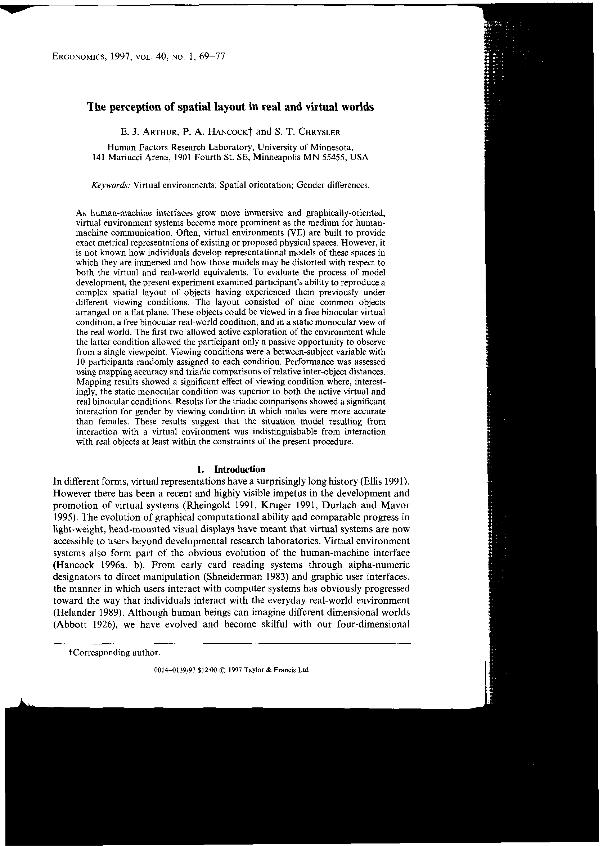The Perception of spatial layout in real and virtual worlds

Contenido multimedia no disponible por derechos de autor o por acceso restringido. Contacte con la institución para más información.
| Tag | 1 | 2 | Valor |
|---|---|---|---|
| LDR | 00000nab a2200000 i 4500 | ||
| 001 | MAP20071030659 | ||
| 003 | MAP | ||
| 005 | 20080418122111.0 | ||
| 007 | hzruuu---uuuu | ||
| 008 | 980907e19970101gbr|||| | |00010|eng d | ||
| 040 | $aMAP$bspa | ||
| 084 | $a875 | ||
| 100 | 1 | $0MAPA20080036812$aArthur, E.J. | |
| 245 | 1 | 4 | $aThe Perception of spatial layout in real and virtual worlds$cE.J. Arthur, P.A. Hancock and S.T. Chrysler |
| 520 | $aAs human-machine interfaces grow more immersive and graphically-oriented, virtual environment systems become more prominent as the medium for human-machine communication. Often, virtual environments are built to provide exact metrical representations of existing or proposed physical spaces. However, it is not known how individuals develop representational models of these spaces in which they are immersed and how those models may be distorted with respect to both the virtual and real-world equivalents. To evaluate the process of model development, the present experiment examined participant's ability to reproduce a complex spatial layout of objects having experienced them previously under different viewing conditions. The layout consisted of nine common objects arranged on a flat plane. These objects could be viewed in a free binocular virtual condition, a free binocular real-world condition, and in a static monocular view of the real world | ||
| 650 | 1 | 1 | $0MAPA20080550653$aErgonomía |
| 650 | 1 | 1 | $0MAPA20080608637$aSistema hombre-máquina |
| 650 | 1 | 1 | $0MAPA20080577636$aRealidad virtual |
| 650 | 1 | 1 | $0MAPA20080565626$aFactor humano |
| 650 | 1 | 1 | $0MAPA20080555818$aPercepción |
| 650 | 1 | 1 | $0MAPA20080562410$aExperimentos |
| 700 | 1 | $0MAPA20080071066$aHancock, P.A. | |
| 700 | 1 | $0MAPA20080094799$aChrysler, S.T. | |
| 740 | 0 | $aErgonomics | |
| 773 | 0 | $tErgonomics$dLondon [etc.]$gVol. 40, nº 1, January 1997 ; p. 69-77 |

